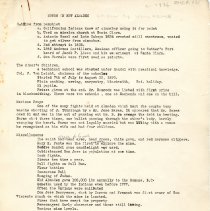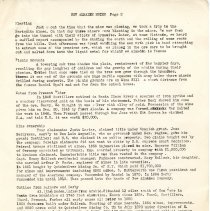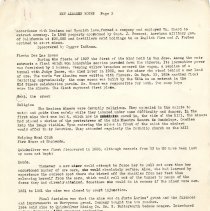Archive Record
Images



Metadata
Catalog number |
2015.8.431 |
Object Name |
Note |
Date |
1936 |
Description |
Notes on New Almaden Outline from pamphlet: a. California Indians knew of cinnabar using it for paint b. Used on mission church at Santa Clara c. Antonio Sunol and Luis Chaboya 1824 erected mill onstream, wanted to get silver from cinnabar. d. 2nd attempt in 1835 e. 1845 Andreas Castillero, Mexican officer going to Sutter's Fort heard of Jacob P. Liese and his experiment at Santa Clara. f. Gun Barrels were first used as retorts. The Miners' Children: A technical school was started under Randol with practical knowledge. Col. F. Von Leicht, chairman of the schools Started 7th of July to August 22, 1890. Plain cooking, sewing, carpentry, blacksmith, Sat. holiday. 51 pupils. Prizes given at the end. Mr. Hancock was listed with first prize in blacksmithing. There were two schools; one at Hacienda and one on the hill. Mexican Frays One of the many fights held at Almaden which kept the courts busy was the shooting of J. Yturriaga by a Mrs. Jose Baras. It appeared that Mr. Baras owed $1 and was in the act of yanking out Mr. Baras to avenge the debt in beating. Baras shot three times; one bullet passing through the other's body, barely escaping the heart. Baras was not legally married, but was living with a woman he recognized as his wife and had four children. Miscellaneous: The saint (Virgin of Guadalupe) had bead eyes, head dress, white gown, and red morocco slippers. Mary H. Foote was the first woman to explore the mine. Before Randol came candlelight was used. Outdistanced San Jose in population at one time. Cock fights. Circus two times a year. Bull fights on Bull Run. Flour battles. Cascarone Ball. Hanging of Judas. Old Almaden gave 100,000 lbs. annually to the Romans, B.C. Mohetka used by the Indians even before 1777. Often the Indians were salivated. Don Jose Berryessa, shot by Carson and Fremont was first owner of San Vincente ranch on which the mine is located. Fires that have swept the property. Personages: Early characters and those still living. Various mine levels. Legends. Various shafts and their workings. Balls and barbeques. School days. Styles. Fads or beliefs of the miners. Blasting Just about the time that the mine was closing, we took a trip to the Enriquita Mines. On that day three miners were blasting in the mines. We saw them go into the tunnel with their sticks of dynamite. Later, at some distance, we heard a muffled report accompanied by the shaking the earth and the rolling of some rocks from the hills. That afternoon was spent watching the men with pick in hand attempting to extract some of the precious ore, which as placed in he ore cars to be brought out and melted down into the liquid metal for which New Almaden is famous. Picnic Grounds A towering oak tree shades the plain reminiscent of far happier days, recalling the gay laughter of children and the gossip of the adults during their picnics. Cables that once were tied on the tree now grow through the branches. At one end of the grounds are huge marble squares with many holes where miners drilled during contests. The picnic grounds are on Mine Hill a short distance from the famous Randol Shaft and not far from the school house. Notes from Fremont Older In 1845 Castillero noticed in Santa Clara River a species of iron pyrite and a rancher discovered gold on the basis of his statement. Father Real showed him some of the ore. Heavy. He thought it was silver with alloy of gold. Possession of the mine given him on December 30, 1845 by first Alcade. A company was formed. War halted the work in 1846. When Fremont passed through San Jose with Kit Carson he visited New Almaden and told U.S. it was worth $30,000. Mine Ownership Four claimants: Justo Larias, claimed title under Spanish grant. Jose Berryessa, sect'y to Don Luis Arguello, who as governor under Mex. regime, gave him grant; Castillero; and U.S. who claimed it as public property. Two claims brought out by the company. Foreign claimants did not want to abide by U.S. Supreme Court decisions. Federal troops stationed at mines. 1858 injuction placed on mine. Emperor William of Germany appointed as tribunal. Emp. awarded property to company with $1,500,000 to Mexican claimant. Incontestable title was then vested int he company. Capt. Henry Halleck residential manager. Furnaces constructed. Mary Halleck, his daughter, who married Arthur D. Foote, engineer of mines in late seventies. In 1861 bought by Quicksilver Mining Co. of N.Y. which paid $1,700,000 for mines and improvements including 8500 acres. Samuel Butterworth was first president and manager of the American company. Succeeded by Randol in 1870. In 1894 Derby succeeded him until 1912. Then passed into the hands of New Almaden Company. Outline from Bulmore and Derby Al, (the) Maden, (mine) from Arabic. Situated 13 miles south of San Jose in Santa Cruz Mountains at 1745 foot elevation. Known since 1824. Sunol, Casillero, Chard, Fremont, Forbes all early names all prior to 1850. 1850 furnaces built under Halleck. Starting of mine records. 1864 mines, improvements, and 8580 acres sold to Quicksilver Mining Company. Up to July 1870 under direction of S. Butterworth then J. Randol to March 1892. 389,122 flasks produced and sold at average of $36.32 flask. Most productive mine except Almaden, Spain. Developed to 2500 feet. Workings would be 1 mile square; In 1896, 325 men busy. 8 furnaces and condensers. Plant considered most complete and most perfect. From September 2, 1923 Mercury In the days of hydraulic mining and in the stamp mills where gold and silver bearing quartz was ground to powder and washed across silvered plates, quickilver was medium by which particles of metal were caught and retained in amalgam. Indians used cinnabar as war paint, many skeletons of Indians were found when Spaniards first opened mines. In 1822 the Indians told Louis Chabolla and Robles of the ore. Later they gave some to Sunol who thought it contained silver and he was disgusted when he found out otherwise. Castillero filed discoverer's claim, upon the ledge in accordance with Mexican and Spanish laws, formed a company and employed Wm. Chard to extract mercury. In 1845 property appraised by Capt. J. Fremont, American military gov. of California at $30,000 and Castillero sold holdings to an English firm and J. Forbes arrived to start mines. Discovered by Digger Indians. Fiesta Des Las Rosas During the fiesta of 1927 the first of its kind held in San Jose. Among the entrants a float which won honorable mention paraded down the streets. Its locomotive power was furnished by 2 horses. Weeping willow branches covered the wagon. A replica of a tunnel with Judge Innes, who died later in 1932, was the miner who stood behind a car load of ore. THe words New Almaden were written with flowers. On Sept. 22, 1934 another float depicting approximately the same scene was built by the SERA as an entrant in the Old Timers celebration parade. Mr. Hauck was responsible for both. Two camp boys were the miners. The float captured first place. Saki, the creek Religion The Mexican miners were devoutly religious. They appealed to the saints to watch and guide them safely while they labored under some difficulty and danger. In the first mine that was built, which now is caved in, the side of the hill, the miners had placed a shrine of the protectress of the mine Nuestra Senora de Guadelupe. Candles kept the image visible. Upon entering the mines in front of the saint this miners would offer their devotion. They attended regularly the Catholic church on the hilll. Helping Hand Club Fire House at Hacienda. Quicksilver was first discovered in 1823, although records from '23 to '50 have been lost or were not kept. Maude Whenever a new miner would attempt to force her to pull out more than her accustomed number of ore cars, she would absolutely refuse. Also, she had learned by experience the correct spot where she kicked off the shackles from her feet thus releasing herself from the cars, which would roll out of the tunnel by means of the force they had already attained. Sometimes she would do it sooner if the miner were new. 1851 to 1861 the mine was closed by court injunction. Final decision was that the mine was on Justo Larias' grant and the furnaces and improvements on Berryessa grant. Company bought the two ranches. 1864 sold mine to Quicksilver Mining Company. Mr. S. Butterworth became manager. Introduced Randol shaft sunk 2450 feet. From 1850 to 1896 New Almaden produced 1,594,049,240 pounds of ore or 942, 447 flasks. Horse Stage Driven by Fred Colliver up to about 1917 or 1918. Mail stage also going out to New Almaden. Terwilliger last mail carrier. named the Star Route to Almaden PO in 1920. Changed to rural route Los Gatos until 1934 when called Almaden PO. No holdups. Open horse stage. Stage left from Joe McKiernan's livery stable once a day. |
People |
Arguello, Luis Baros, Jose Berryessa, Jose Reyes Bulmore, Robert Richard Butterworth, Samuel Fowler Carson, Christopher "Kit" Huston Castillero, Andres Colliver, Frederic Cornelius Derby, Thomas (Tom) Emperor William of Germany Foote, Arthur DeWint Foote, Mary Hallock Fremont, John C. Halleck, Henry (Wager, Sr., Jr.) Halleck, Mary Larios, Justo Leise, Jacob P. Randol, James Butterworth Real, Jose Maria (Padre) (Fr.) Robles, Secundino Sunol, Antonio Terwilliger Von Leicht, F. Yturriaga, Joaquin McKiernan, Joe M. Hauck, Fred (F.P., Jr., Sr.) |
Cataloged by |
Wicks, Susan |
Credit line |
Donated by the Wright-Hauck family |
